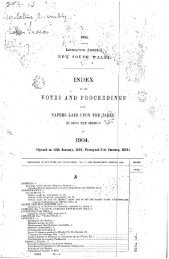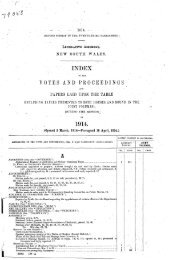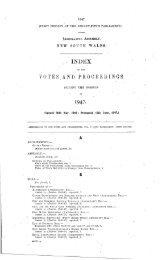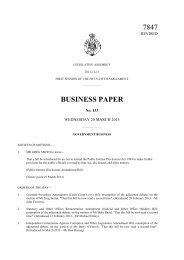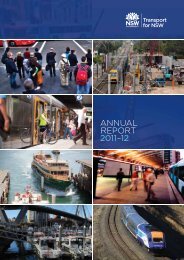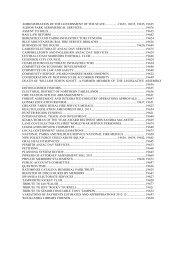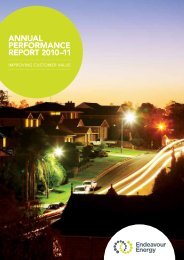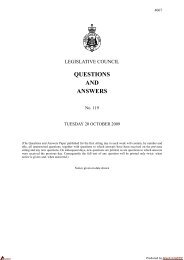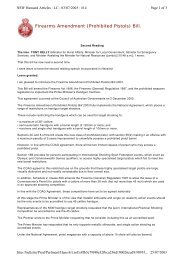Questions & Answers Paper No. 158 - Parliament of New South ...
Questions & Answers Paper No. 158 - Parliament of New South ...
Questions & Answers Paper No. 158 - Parliament of New South ...
You also want an ePaper? Increase the reach of your titles
YUMPU automatically turns print PDFs into web optimized ePapers that Google loves.
7086<br />
LEGISLATIVE ASSEMBLY QUESTIONS AND ANSWERS<br />
MONDAY 12 OCTOBER 2009<br />
provides the client, referrer and others involved, with information about contacting other support<br />
services.<br />
Home Care staff are continually participating in local HACC forums and liaise with key referral agencies,<br />
such as Commonwealth Carelink and NSW Health services to ensure that information on intake to Home<br />
Care services is available to any member <strong>of</strong> the community who requires assistance.<br />
(4) ADHC funds almost 600 government and non-government providers to provide HACC services. In<br />
the event that a particular organisation is unable to provide a requested service, clients can be referred to<br />
another service in the area, and be provided with information about the Commonwealth Carelink Centre<br />
(contact number 1800 052 222).<br />
The Commonwealth Carelink Centre maintains a comprehensive database containing community aged<br />
care, disability and other support services. This service acts as a central point <strong>of</strong> contact for the general<br />
public and provides advice and information to clients regarding which services are available in their local<br />
areas.<br />
(5) Service planning, including the assessment <strong>of</strong> service gaps, is conducted annually at the regional<br />
level. The planning process involves extensive consultation with all stakeholders and analysis <strong>of</strong> various<br />
data sets.<br />
Information on unmet needs is used to inform planning for services. For example, the regional planning<br />
for 2008-09 identified unmet need for personal care and domestic assistance services in the <strong>South</strong> East<br />
Sydney LPA, which covers inner city Sydney. In response, additional funding <strong>of</strong> $1.9 million was<br />
provided for HACC service expansion in this planning area in 2008-09.<br />
(6) There has been a steady increase <strong>of</strong> around 7% a year in HACC funding over several years. ADHC<br />
has completed the HACC Planning process for 2009-10 and 2010-11 and details <strong>of</strong> service expansion<br />
have been included in the Annual Supplements to the HACC Triennial Plan (2008-11) for these two<br />
years. The Annual Supplements are currently awaiting Australian Government approval. Planned HACC<br />
funding for <strong>South</strong> East Sydney LPA for 2009-10 is $62.8 million, and for the Inner West LPA HACC<br />
funding is $33.6 million.<br />
*7461 RTA NOISE ABATEMENT PROGRAM—Ms Clover Moore asked the Minister for Roads—<br />
(1) How many applications did the Roads and Traffic Authority (RTA) receive for treatment against the<br />
effects <strong>of</strong> very high road traffic noise on properties near noisy roads under the <strong>No</strong>ise Abatement<br />
Program:<br />
(a) last financial year;<br />
(b) the financial year for 2007-08;<br />
(c) the financial year for 2006-07?<br />
(2) How many <strong>of</strong> these applications received amelioration under the <strong>No</strong>ise Abatement Program?<br />
(3) How many <strong>of</strong> these applications were refused under the <strong>No</strong>ise Abatement Program?<br />
(4) Of those that were refused, how many were for residential properties that experienced noise levels <strong>of</strong><br />
at least 65 decibels during the day or 60 decibels during the night?<br />
(5) How many applications did the RTA receive for treatment against the effects <strong>of</strong> very high road traffic<br />
noise on properties near noisy roads in the Sydney electorate under the <strong>No</strong>ise Abatement Program:<br />
(a) last financial year;<br />
(b) the financial year for 2007-08;<br />
(c) the financial year for 2006-07?<br />
(6) How many <strong>of</strong> the Sydney electorate applications received amelioration under the <strong>No</strong>ise Abatement<br />
Program?<br />
(7) How many <strong>of</strong> the Sydney electorate applications were refused under the <strong>No</strong>ise Abatement Program?<br />
(8) Of those that were refused, how many were for residential properties that experienced noise levels <strong>of</strong><br />
at least 65 decibels during the day or 60 decibels during the night?<br />
(9) What plans does the Government have to expand the program to ensure that residents can be<br />
protected from very high levels <strong>of</strong> traffic noise?<br />
Answer—<br />
I am advised:<br />
(1) (a) 110.<br />
(b) 132.<br />
(c) 203.<br />
(2) 146.<br />
Produced by Alts<strong>of</strong>t Xml2PDF



